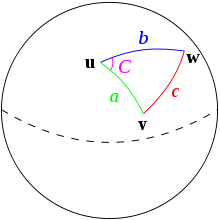Half-side formula
In spherical trigonometry, the half side formula relates the angles and lengths of the sides of spherical triangles, which are triangles drawn on the surface of a sphere and so have curved sides and do not obey the formulas for plane triangles.[1]

Spherical triangle
Formulas
On a unit sphere, the half-side formulas are[2]
where
- a, b, c are the lengths of the sides respectively opposite angles A, B, C,
- is half the sum of the angles, and
The three formulas are really the same formula, with the names of the variables permuted.
To generalize to a sphere of arbitrary radius r, the lengths a,b,c must be replaced with
so that a,b,c all have length scales, instead of angular scales.
gollark: Minix, I mean.
gollark: It runs on your CPU anyway, if you have an Intel one.
gollark: Use Minix.
gollark: Why not use LFS?
gollark: They know, Keanu. The enforcer squad is arriving tomorrow.
See also
- Spherical law of cosines
- Law of haversines
References
- Bronshtein, I. N.; Semendyayev, K. A.; Musiol, Gerhard; Mühlig, Heiner (2007), Handbook of Mathematics, Springer, p. 165, ISBN 9783540721222
- Nelson, David (2008), The Penguin Dictionary of Mathematics (4th ed.), Penguin UK, p. 529, ISBN 9780141920870.
This article is issued from Wikipedia. The text is licensed under Creative Commons - Attribution - Sharealike. Additional terms may apply for the media files.